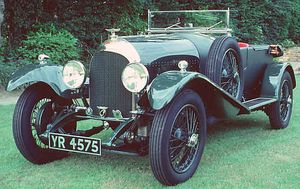.
Bentley 3 Litre: Difference between revisions
Red marquis (talk | contribs) No edit summary |
Red marquis (talk | contribs) No edit summary |
||
| Line 49: | Line 49: | ||
| {{{Designer (lead designer if it was a team effort)}}} | | {{{Designer (lead designer if it was a team effort)}}} | ||
|} | |} | ||
The '''3 Litre''' was the [[sports car]] that put [[Bentley]] on the automotive map. It was a large car compared to the tiny, lightweight [[Bugatti]]s then dominating racing, but its innovative technology and strength made up for its weight. The 4000 lb (1800 kg) car won the [[24 Hours of Le Mans]] in [[1924]] with drivers, [[John Duff]] and [[Frank Clement]]. Its weight, size, and speed prompted [[Ettore Bugatti]] to call it "the fastest [[truck|lorry]] in the world." | |||
==Coachwork== | |||
The 3 Litre was delivered as a running chassis, with Bentley referring many customers to [[Vanden Plas]] for standard bodies. Most were open touring cars, but some variety was inevitable with custom [[coachwork]]. Customers included [[Prince George, Duke of Kent]], [[Gertrude Lawrence]], and [[Beatrice Lilliewere]]. | |||
==Engineering== | |||
The 3.0 L (2996 cc/182 in³) [[straight-4]] engine was large for its day, but it was its technical innovations that were most noticed. It was one of the first production engines with [[multi-valve|4 valves per cylinder]], and these were driven by an [[overhead camshaft]]. It was also among the first with two [[spark plug]]s per cylinder, pent-roof combustion chambers, and twin [[carburetor]]s. It was extremely [[undersquare]], optimized for low-end [[torque]], with a bore of 80 mm (3.1 in) and a stroke of 149 mm (5.9 in). To increase durability, the iron engine block and cylinder head were cast as a single unit. | |||
Power output was roughly 70 hp (52 kW), allowing the 3 Litre to hit 80 mph (129 km/h). The Speed Model could reach 90 mph (145 km/h), while the Super Sports passed 100 mph (161 km/h). | |||
==Production== | |||
[[Image:Bentley 3-Litre Drophead Coupe 1921.jpg|thumb|250px|Bentley 3-Litre Drophead Coupé 1921]] | |||
[[Image:Bentley 3-Litre Speed Model 4-Seater Tourer 1925.jpg|thumb|250px|Bentley 3-Litre Speed Model 4-Seater Tourer 1925]] | |||
[[Image:Bentley 3-Litre Boattail 1927.jpg|thumb|250px|Bentley 3-Litre Boattail 1927]] | |||
The 3 Liter car was shown at the [[1919]] [[London Motor Show]], but the engine had not yet been finished. It took two years to get the engine right, with the first customer delivery in September of [[1921]]. Production lasted through [[1929]], by which time the car had been surpassed by Bentley's own [[Bentley 4.5 Litre|4½ Litre]] car. | |||
* Experimental: 3 | |||
* 3 Litre: 1088 | |||
* Speed Model: 513 | |||
* Super Sports: 18 | |||
==Gallery== | ==Gallery== | ||
<gallery> | <gallery> | ||
Image:1924 Le Mans Winning 3 Litre Bentley-100.jpg | Image:1924 Le Mans Winning 3 Litre Bentley-100.jpg | ||
</gallery> | </gallery> | ||
{{Bentley}} | {{Bentley}} | ||
[[Category:Bentley vehicles|3 Litre]] | |||
Revision as of 03:37, 5 March 2007

| |
| Bentley 3 Litre | |
|---|---|
| Bentley | |
| aka | {{{aka (Type here, not up there)}}} |
| Production | {{{produced from when to when+total units made (optional)}}} |
| Class | {{{Class}}} |
| Body Style | {{{Body-Style}}} |
| Length | {{{length - type here}}} |
| Width | {{{Width - type here}}} |
| Height | {{{Height - type here}}} |
| Wheelbase | {{{wheelbase - type here}}} |
| Weight | {{{Weight - you get the point}}} |
| Transmission | {{{transmission + drive}}} |
| Engine | {{{engine}}} |
| Power | {{{Horsepower and Torque rating}}} |
| Similar | {{{similar (competition)}}} |
| Designer | {{{Designer (lead designer if it was a team effort)}}} |
The 3 Litre was the sports car that put Bentley on the automotive map. It was a large car compared to the tiny, lightweight Bugattis then dominating racing, but its innovative technology and strength made up for its weight. The 4000 lb (1800 kg) car won the 24 Hours of Le Mans in 1924 with drivers, John Duff and Frank Clement. Its weight, size, and speed prompted Ettore Bugatti to call it "the fastest lorry in the world."
Coachwork
The 3 Litre was delivered as a running chassis, with Bentley referring many customers to Vanden Plas for standard bodies. Most were open touring cars, but some variety was inevitable with custom coachwork. Customers included Prince George, Duke of Kent, Gertrude Lawrence, and Beatrice Lilliewere.
Engineering
The 3.0 L (2996 cc/182 in³) straight-4 engine was large for its day, but it was its technical innovations that were most noticed. It was one of the first production engines with 4 valves per cylinder, and these were driven by an overhead camshaft. It was also among the first with two spark plugs per cylinder, pent-roof combustion chambers, and twin carburetors. It was extremely undersquare, optimized for low-end torque, with a bore of 80 mm (3.1 in) and a stroke of 149 mm (5.9 in). To increase durability, the iron engine block and cylinder head were cast as a single unit.
Power output was roughly 70 hp (52 kW), allowing the 3 Litre to hit 80 mph (129 km/h). The Speed Model could reach 90 mph (145 km/h), while the Super Sports passed 100 mph (161 km/h).
Production
The 3 Liter car was shown at the 1919 London Motor Show, but the engine had not yet been finished. It took two years to get the engine right, with the first customer delivery in September of 1921. Production lasted through 1929, by which time the car had been surpassed by Bentley's own 4½ Litre car.
- Experimental: 3
- 3 Litre: 1088
- Speed Model: 513
- Super Sports: 18

